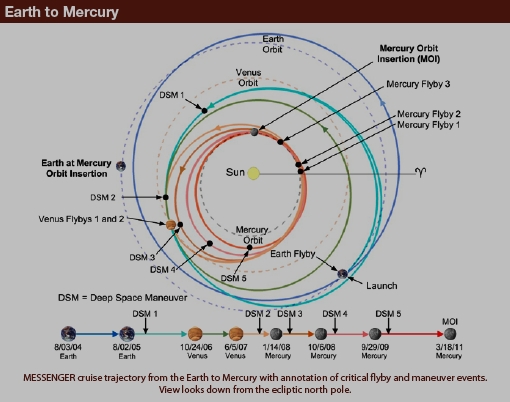. check to a description of MESSENGER Mercury Orbit Insertion (MOI)
 back Space
back Space
![]() LATEST! After fuel depletion, the mission was eventually slammed, and terminated, unto Mercury's surface on April 30th, 2015!
LATEST! After fuel depletion, the mission was eventually slammed, and terminated, unto Mercury's surface on April 30th, 2015!
. check to a description of MESSENGER Mercury Orbit Insertion (MOI)
Messenger (MErcury Surface, Space ENvironment, GEochemistry, and Ranging) mission is a NASA mission to Mercury, and the first since Mariner 10 which flew by the planet thirty years ago in a joint mission to Venus. Messenger will lead a thorough study of Mercury orbiting in an extremely elliptical orbit which will bring the craft from 120 miles above the planet to 9,000 miles away. Messenger launched August 3rd, 2004 from Cape Canaveral Air Force Station. It will settled into a definitive orbit about Mercury in March 2011 after three flybys of the planet in January and October 2008, and September 2009, as the craft will have performed three gravity assists (two at Venus in October 2006 and June 2007, one at Earth in 2005). Mission is scheduled to last one year as the planet will ultimately draw the spacecraft into its surface. A return journey of a command sent to MESSENGER is taking between 4-12 minutes, depending on the distance from Earth as 8 of every 24 hours will be dedicated to a downlink of data at 15 Mb/sec, with the spacecraft orbiting the planet once every 12 hours. It is of note that the upcoming, ESA BepiColombo mission will benefit of MESSENGER data; both missions further, generally complement each other in terms of science
MESSENGER wide-angle camera (WAC), not a typical color camera, can image in 11 colors, ranging from 430 to 1020 nm wavelength, or from the visible through near-infrared, using a filter wheel. Just eight of the WAC's filters will be used during science operations to reduce the amount of data that must be stored on the spacecraft’s solid-state recorder before downlink or to allow quicker imaging than through cycling through all 11 filters as the spacecraft is moving rapidly over the surface. WAC images will be used in coordination with the Mercury Atmospheric and Surface Composition Spectrometer (MASCS), a hyperspectral instrument that provides reflectance information at many more wavelengths
